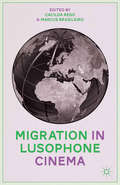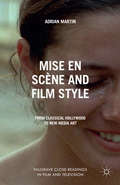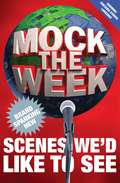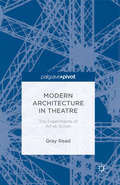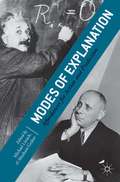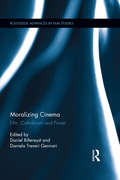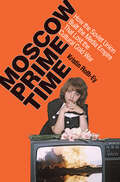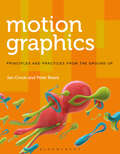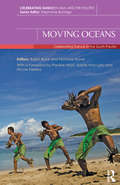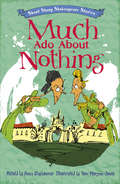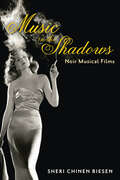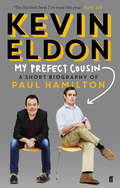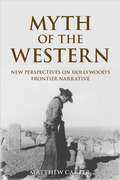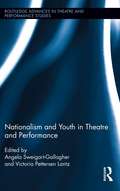- Table View
- List View
Migration in Lusophone Cinema
by Cacilda Rêgo Marcus BrasileiroWith more than 250 million speakers globally, the Lusophone world has a rich history of filmmaking. This edited volume explores the representation of the migratory experience in contemporary cinema from Portuguese-speaking countries, exploring how Lusophone films, filmmakers, producers, studios, and governments relay narratives of migration.
Mise en Scène and Film Style: From Classical Hollywood to New Media Art (Palgrave Close Readings in Film and Television)
by A. MartinStyles of filmmaking have changed greatly from classical Hollywood through to our digital era. So, too, have the ways in which film critics and scholars have analysed these transformations in film style. This book explores two central style concepts, mise en scène and dispositif, to illuminate a wide range of film and new media examples.
Mock the Week: Brand Spanking New Scenes We'd Like To See
by Dan PattersonModern life is a minefield. Fortunately, the creators of Mock the Week are here to give you advice on the important things in life: from office etiquette to camping holidays, the worst things to hear while sitting on the toilet -- and what not to say when passing through Customs . . . Categories include:Unlikely Things to Hear at a Funeral: 'Could whoever that is stop knocking, I'm trying to do the Eulogy!'Unlikely Things to Say on Your First Day in Prison: 'How thoughtful! Someone's left a bucket of chocolate mousse in the corner of my cell.'Guide to Keeping Tropical Fish: For a special treat, pour a smoothie slowly into the fish tank. They love that.Mountaineering Tips: Try to make sure you are accompanied by an experienced mountaineer or, failing that, someone really fat who will make for a soft landing.Medical Self-Diagnosis: If it comes out faster than gravity would normally allow, then there's something wrong.
Modern Architecture in Theatre: The Experiments of Art et Action
by A. ReadIf the city is the theatre of urban life, how does architecture act in its many performances? This book reconstructs the spatial experiments of Art et Action, a theatre troupe active in 1920s Paris, and how their designs for theater buildings show how the performance spaces interacted with actors and spectators according to their type.
Modes of Explanation: Affordances for Action and Prediction
by Michael Lissack Abraham GraberModes of Explanation is the first book in decades to attempt to bring these conflicting approaches together and to offer a compelling narrative to explore how the paradox of 'explanation' can converge.
Moralizing Cinema: Film, Catholicism, and Power (Routledge Advances in Film Studies)
by Daniël Biltereyst Daniela Treveri GennariThis volume is part of the recent interest in the study of religion and popular media culture (cinema in particular), but it strongly differs from most of this work in this maturing discipline. Contrary to most other edited volumes and monographs on film and religion, Moralizing Cinema will not focus upon films (cf. the representation of biblical figures, religious themes in films, the fidelity question in movies), but rather look beyond the film text, content or aesthetics, by concentrating on the cinema-related actions, strategies and policies developed by the Catholic Church and Catholic organizations in order to influence cinema. Whereas the key role of Catholics in cinema has been well studied in the USA (cf. literature on the Legion of Decency and on the Catholic influenced Production Code Administration), the issue remains unexplored for other parts of the world. The book includes case studies on Argentina, Belgium, France, Ireland, Italy, Luxemburg, the Netherlands, and the USA.
Moralizing Cinema: Film, Catholicism, and Power (Routledge Advances in Film Studies)
by Daniel Biltereyst Daniela Treveri GennariThis volume is part of the recent interest in the study of religion and popular media culture (cinema in particular), but it strongly differs from most of this work in this maturing discipline. Contrary to most other edited volumes and monographs on film and religion, Moralizing Cinema will not focus upon films (cf. the representation of biblical figures, religious themes in films, the fidelity question in movies), but rather look beyond the film text, content or aesthetics, by concentrating on the cinema-related actions, strategies and policies developed by the Catholic Church and Catholic organizations in order to influence cinema. Whereas the key role of Catholics in cinema has been well studied in the USA (cf. literature on the Legion of Decency and on the Catholic influenced Production Code Administration), the issue remains unexplored for other parts of the world. The book includes case studies on Argentina, Belgium, France, Ireland, Italy, Luxemburg, the Netherlands, and the USA.
Moscow Prime Time: How the Soviet Union Built the Media Empire that Lost the Cultural Cold War
by Kristin Roth-EyWhen Nikita Khrushchev visited Hollywood in 1959 only to be scandalized by a group of scantily clad actresses, his message was blunt: Soviet culture would soon consign the mass culture of the West, epitomized by Hollywood, to the "dustbin of history." In Moscow Prime Time, a portrait of the Soviet broadcasting and film industries and of everyday Soviet consumers from the end of World War II through the 1970s, Kristin Roth-Ey shows us how and why Khrushchev’s ambitious vision ultimately failed to materialize. The USSR surged full force into the modern media age after World War II, building cultural infrastructures—and audiences—that were among the world’s largest. Soviet people were enthusiastic radio listeners, TV watchers, and moviegoers, and the great bulk of what they were consuming was not the dissident culture that made headlines in the West, but orthodox, made-in-the-USSR content. This, then, was Soviet culture’s real prime time and a major achievement for a regime that had long touted easy, everyday access to a socialist cultural experience as a birthright. Yet Soviet success also brought complex and unintended consequences. Emphasizing such factors as the rise of the single-family household and of a more sophisticated consumer culture, the long reach and seductive influence of foreign media, and the workings of professional pride and raw ambition in the media industries, Roth-Ey shows a Soviet media empire transformed from within in the postwar era. The result, she finds, was something dynamic and volatile: a new Soviet culture, with its center of gravity shifted from the lecture hall to the living room, and a new brand of cultural experience, at once personal, immediate, and eclectic—a new Soviet culture increasingly similar, in fact, to that of its self-defined enemy, the mass culture of the West. By the 1970s, the Soviet media empire, stretching far beyond its founders’ wildest dreams, was busily undermining the very promise of a unique Soviet culture—and visibly losing the cultural cold war. Moscow Prime Time is the first book to untangle the paradoxes of Soviet success and failure in the postwar media age.
Motion Graphics: Principles and Practices from the Ground Up (Required Reading Range)
by Ian Crook Mr Peter BeareSong lyrics fly across the screen in time to music. A globe spins and zooms into a war-torn country. Money rises from a screen to explain an economic situation. Now, more than ever, we are surrounded by these motion graphics on our TV and cinema screens, on our smartphones, computers, and tablets, on Main Street and in our galleries.Motion Graphics: Principles and Processes from the Ground Up is your introduction to the core principles of the discipline, whether your background or ambitions lie in animation, graphic design, film production, or visual effects. Ian Crook and Peter Beare provide you with a wide understanding of the key concepts and techniques that will help you plan, develop and produce your own creative projects.
Movie Bliss: A Hopeless Romantic Seeks Movies To Love (Mills And Boon E Ser. #3)
by Heidi RiceThe Romance Lover's Guide to Movie Must-Sees
Movie Stunts & Special Effects: A Comprehensive Guide to Planning and Execution
by Andrew LaneThroughout film history, one of the fundamental fantasies portrayed on screen has been the kind of physical action few of us could ever experience in real life. The image of an 'every man' engaged in hand-to-hand, mortal combat, defending his family or even the world population against an overwhelming and malevolent force, speaks to our most primal instincts and thus became a mainstay of movie entertainment. In order to translate these deep-seated fantasies to the screen, filmmakers have been developing special skills and crafts for over 100 years. It is these skills that make 'movie magic' and have allowed audiences to take part in the primal hopes and fears we all possess. Movie Stunts & Special Effects: A Comprehensive Guide to Planning and Execution is designed to inform filmmakers on how to plan for and utilize these crafts by engaging and empowering filmmakers to better communicate with stunts and effects practitioners, and thereby enabling them to more fully realize their vision. Director/Producer Andrew Lane surveys fights, use of weapons, cars and vehicles, falls, the use of pyrotechnics, atmospheric effects, bullet hits, wounds and blood, among many other categories. Factors such as cost, time to implement, safety accommodations, and assessing the competence of those employed to plan and execute stunts and special effects are numerous and very specific. Each topic in Movie Stunts & Special Effects is examined using narrative explanations and extensive interviews with world-renowned experts. Various stunts and special effects are explored in the context of how they are best captured by a camera and then editorially constituted in the final product.
Moving Oceans: Celebrating Dance in the South Pacific (Celebrating Dance in Asia and the Pacific)
by Nicholas Rowe Ralph BuckCelebrating the diversity of dance across the South Pacific, this volume studies the various experiences, motivations and aims for dance, emerging from the voices of dance professionals in the islands. In particular, it focuses on the interplay of cultures and pathways of migration as people move across the region discovering new routes and connections.
Moving Oceans: Celebrating Dance in the South Pacific (Celebrating Dance in Asia and the Pacific)
by Nicholas Rowe Ralph BuckCelebrating the diversity of dance across the South Pacific, this volume studies the various experiences, motivations and aims for dance, emerging from the voices of dance professionals in the islands. In particular, it focuses on the interplay of cultures and pathways of migration as people move across the region discovering new routes and connections.
The Moving Researcher: Laban/Bartenieff Movement Analysis in Performing Arts Education and Creative Arts Therapies
by Ciane FernandesThe Moving Researcher offers a complete approach to Laban/Bartenieff Movement Analysis, detailing the original method, exploring recent developments and examining its applications. With contributions from internationally renowned professionals at key institutions, this book covers all concepts taught as part of the Certificate of Movement Analysis.
Much Ado About Nothing (Short, Sharp Shakespeare Stories #5)
by Anna ClaybourneMistaken identities, deceipt, lovers' quarrels and a happy ending... discover the entertaining story at the heart of Much Ado About Nothing, one of Shakespeare's best-loved comedies. The age-appropriate text in Short, Sharp Shakespeare Stories: Much Ado About Nothing introduces readers to the play by re-telling the story in modern English, making it an ideal introduction to Shakespeare for children of 9 and above. The book also contains information about the background to Much Ado About Nothing, its major themes, language, and Shakespeare's life during the time he was writing the play, so is a useful resource for project work, or for anyone studying the play itself.Gossip, and its role in society in 16th century England, is also examined, to give the play a factual grounding.Anna Claybourne's concise, witty text really brings out the humour and the drama of the stories, rendering them as relevant today as they were in Shakespeare's time. Comparisons with themes in modern life: love, revenge, family relationships, political power struggles, etc., serve to reinforce this.The text is supported by Tom Morgan-Jones' fantastic artwork, giving the series real visual appeal. Short, Sharp Shakespeare Stories allow children today to be as enthralled by Shakespeare's tales as audiences were 400 years ago. Other titles in the series include Macbeth, A Midsummer Night's Dream, The Tempest, Romeo and Juliet and Hamlet.
Music in the Shadows: Noir Musical Films
by Sheri Chinen BiesenSmoke. Shadows. Moody strains of jazz. Welcome to the world of "noir musical" films, where tormented antiheroes and hard-boiled musicians battle obsession and struggle with their music and ill-fated love triangles. Sultry divas dance and sing the blues in shrouded nightclubs. Romantic intrigue clashes with backstage careers. In her pioneering study, Music in the Shadows, film noir expert Sheri Chinen Biesen explores musical films that use film noir style and bluesy strains of jazz to inhabit a disturbing underworld and reveal the dark side of fame and the American Dream. While noir musical films like A Star Is Born include musical performances, their bleak tone and expressionistic aesthetic more closely resemble the visual style of film noir. Their narratives unfold behind a stark noir lens: distorted, erratic angles and imbalanced hand-held shots allow the audience to experience a tortured, disillusioned perspective.While many musicals glamorize the quest for the spotlight in Hollywood's star factory, brooding noir musical films such as Blues in the Night, Gilda, The Red Shoes, West Side Story, and Round Midnight stretch the boundaries of film noir and the musical as film genres collide. Deep shadows, dim lighting, and visual composition evoke moodiness, cynicism, pessimism, and subjective psychological points of view.As in her earlier study of film noir, Blackout: World War II and the Origins of Film Noir, Biesen draws on extensive primary research in studio archives to situate her examination within a historical, industrial, and cultural context.
Music in the Shadows: Noir Musical Films
by Sheri Chinen BiesenSmoke. Shadows. Moody strains of jazz. Welcome to the world of "noir musical" films, where tormented antiheroes and hard-boiled musicians battle obsession and struggle with their music and ill-fated love triangles. Sultry divas dance and sing the blues in shrouded nightclubs. Romantic intrigue clashes with backstage careers. In her pioneering study, Music in the Shadows, film noir expert Sheri Chinen Biesen explores musical films that use film noir style and bluesy strains of jazz to inhabit a disturbing underworld and reveal the dark side of fame and the American Dream. While noir musical films like A Star Is Born include musical performances, their bleak tone and expressionistic aesthetic more closely resemble the visual style of film noir. Their narratives unfold behind a stark noir lens: distorted, erratic angles and imbalanced hand-held shots allow the audience to experience a tortured, disillusioned perspective.While many musicals glamorize the quest for the spotlight in Hollywood's star factory, brooding noir musical films such as Blues in the Night, Gilda, The Red Shoes, West Side Story, and Round Midnight stretch the boundaries of film noir and the musical as film genres collide. Deep shadows, dim lighting, and visual composition evoke moodiness, cynicism, pessimism, and subjective psychological points of view.As in her earlier study of film noir, Blackout: World War II and the Origins of Film Noir, Biesen draws on extensive primary research in studio archives to situate her examination within a historical, industrial, and cultural context.
Music, Performance, and the Realities of Film: Shared Concert Experiences in Screen Fiction (Routledge Research in Music)
by Ben WintersThis book examines the relationship between narrative film and reality, as seen through the lens of on-screen classical concert performance. By investigating these scenes, wherein the performance of music is foregrounded in the narrative, Winters uncovers how concert performance reflexively articulates music's importance to the ontology of film. The book asserts that narrative film of a variety of aesthetic approaches and traditions is no mere copy of everyday reality, but constitutes its own filmic reality, and that the music heard in a film's underscore plays an important role in distinguishing film reality from the everyday. As a result, concert scenes are examined as sites for provocative interactions between these two realities, in which real-world musicians appear in fictional narratives, and an audience’s suspension of disbelief is problematised. In blurring the musical experiences of onscreen observers and participants, these concert scenes also allegorize music’s role in creating a shared subjectivity between film audience and character, and prompt Winters to propose a radically new vision of music’s role in narrative cinema wherein musical underscore becomes part of a shared audio-visual space that may be just as accessible to the characters as the music they encounter in scenes of concert performance.
Music, Performance, and the Realities of Film: Shared Concert Experiences in Screen Fiction (Routledge Research in Music)
by Ben WintersThis book examines the relationship between narrative film and reality, as seen through the lens of on-screen classical concert performance. By investigating these scenes, wherein the performance of music is foregrounded in the narrative, Winters uncovers how concert performance reflexively articulates music's importance to the ontology of film. The book asserts that narrative film of a variety of aesthetic approaches and traditions is no mere copy of everyday reality, but constitutes its own filmic reality, and that the music heard in a film's underscore plays an important role in distinguishing film reality from the everyday. As a result, concert scenes are examined as sites for provocative interactions between these two realities, in which real-world musicians appear in fictional narratives, and an audience’s suspension of disbelief is problematised. In blurring the musical experiences of onscreen observers and participants, these concert scenes also allegorize music’s role in creating a shared subjectivity between film audience and character, and prompt Winters to propose a radically new vision of music’s role in narrative cinema wherein musical underscore becomes part of a shared audio-visual space that may be just as accessible to the characters as the music they encounter in scenes of concert performance.
Musical Theatre Auditions and Casting: A performer's guide viewed from both sides of the audition table
by Neil RutherfordMusical theatre is a tough and over-crowded industry. Yet, despite the huge competition, many performers find auditioning difficult with little knowledge of what the directors, creative teams and producers are looking for, or how to win the panel over with their unique talent. As a leading international casting director, Neil Rutherford has seen thousands of hopefuls audition over the years. Uniquely, he also understands what it is like to audition from his years as a professional actor in musical theatre.This book provides a unique perspective on the musical theatre audition process and how to improve the chances of landing a role. With wit, humour and insight, Neil Rutherford guides the reader through the crucial elements of musical theatre auditions, opening up the process of casting and auditioning to the thousands of hopefuls trying to secure work in this industry every year, as well as anyone involved in musical theatre. With a foreword by Tony-award-winning director Bartlett Sher, the book also contains contributions from some of the world's leading directors and musical directors, including Sir Richard Eyre and Jerry Mitchell, adding further valuable insight from those at the centre of the musical theatre world. This book is a vital tool for anyone hoping to improve their audition chances and survive in the world of musical theatre.
My Prefect Cousin: A Short Biography of Paul Hamilton
by Kevin EldonEliot, Heaney, Auden, Larkin, Plath. Faber & Faber are famous the world over for publishing the works of the giants of poetry. And now with My Prefect Cousin they are proud to introduce to you the poems of cult poet Paul Hamilton. Paul who? A reasonable question. Hamilton, once described by the Poetic Literary Review as 'a diabolical libertarian', has remained firmly under the public radar ever since he first started writing poetry in the early nineties. But now it is time for him to receive the recognition he deserves. Hamilton's cousin, Kevin Eldon, stand up comedian and stalwart of numerous television and radio comedies over the last twenty years, presents a fascinating insight into the life, work and times of a poet who stands in a class all of his own. My Prefect Cousin charts the roller coaster ride of a life dedicated to verse; the emotional highs, the murky depths, with personal contributions from Hamilton that are often characterised by a brutal honesty that is not for the faint hearted. Or indeed the weak stomached. My Prefect Cousin also contains for the very first time on the printed page 'Shadows of Reflections', the anthology of poetry Hamilton has failed for so long to find a publisher for. Until now.
Myth of the Western
by Matthew CarterMyth of the Western re-invigorates the debate surrounding the relationship between the Western and frontier mythology, arguing for the importance of the genre’s socio-cultural, historical and political dimensions.
Naked Cinema: Working with Actors
by Sally PotterSally Potter has been renowned for her rapport with actors, and for the luminous performances she works with them to produce. Now she strips bare the art and craft of directing actors for the camera, from casting a film to the moment of first screening when the work goes public. A brilliant writer for the screen, here Potter shows herself to be expert at translating the experience of film directing to the page. She addresses us in prose that is both unsentimental and inspired, tracing the energies that pass between actor, director and audience; shaping for the reader the acts of transmission and imagination, performance and witness, the sum of which make up a film.In addition to the core text, the book contains interviews with actors with whom Sally Potter has worked, whose voices will counterpoint Sally Potter's, and will inform and illuminate the reader's sense of her work. Those interviewed include: Julie Christie, Johnny Depp, Jude Law, Judi Dench, Simon Abkarian, Annette Benning, Timothy Spall, Steve Buscemi, Riz Ahmed, Elle Fanning, Alessandro Nivola, and Lily Cole.
Nationalism and Youth in Theatre and Performance (Routledge Advances in Theatre & Performance Studies)
by Angela Sweigart-Gallagher Victoria Pettersen LantzNationalism and Youth in Theatre and Performance explores how children and young people fit into national political theatre and, moreover, how youth enact interrogative, patriotic, and/or antagonistic performances as they develop their own relationship with nationhood. Children are often seen as excluded from public discourse or political action. However, this idea of exclusion is false both because adults place children at the center of political debates (with the rhetoric of future generations) and because children actively insert themselves into public discourse. Whether performing a national anthem for visiting heads of state, creating a school play about a country’s birth, or marching in protest of a change in public policy, young people use theatre and performance as a means of publicly staking a claim in national politics, directly engaging with ideas of nationalism around the world. This collection explores the issues of how children fit into national discourse on international stages. The authors focus on national performances by/for/with youth and examine a wide range of performances from across the globe, from parades and protests to devised and traditional theatre. Nationalism and Youth in Theatre and Performance rethinks how national performance is defined and offers previously unexplored historical and theoretical discussions of political youth performance.
Nationalism and Youth in Theatre and Performance (Routledge Advances in Theatre & Performance Studies)
by Victoria Pettersen Lantz Angela Sweigart-GallagherNationalism and Youth in Theatre and Performance explores how children and young people fit into national political theatre and, moreover, how youth enact interrogative, patriotic, and/or antagonistic performances as they develop their own relationship with nationhood. Children are often seen as excluded from public discourse or political action. However, this idea of exclusion is false both because adults place children at the center of political debates (with the rhetoric of future generations) and because children actively insert themselves into public discourse. Whether performing a national anthem for visiting heads of state, creating a school play about a country’s birth, or marching in protest of a change in public policy, young people use theatre and performance as a means of publicly staking a claim in national politics, directly engaging with ideas of nationalism around the world. This collection explores the issues of how children fit into national discourse on international stages. The authors focus on national performances by/for/with youth and examine a wide range of performances from across the globe, from parades and protests to devised and traditional theatre. Nationalism and Youth in Theatre and Performance rethinks how national performance is defined and offers previously unexplored historical and theoretical discussions of political youth performance.
